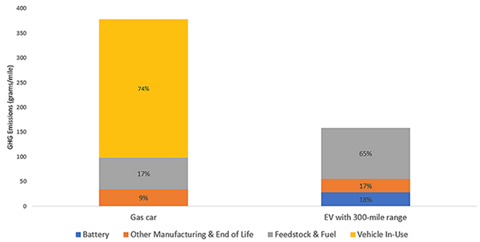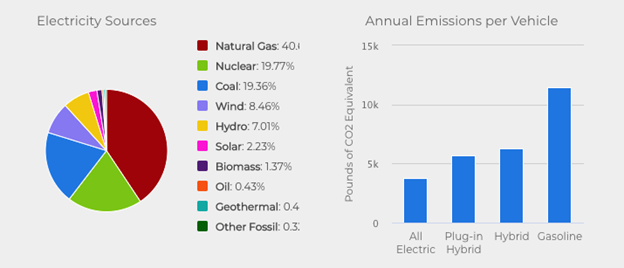Everyone loves a good story. Stories are how we make information stick. They once were our only lifeline to history, and we continue to teach our children using stories. As well, good storytelling is critically important in how we entertain ourselves.
But even if a story sounds believable, it isn’t always true. Maybe even more than a good story, humanity craves deeper understanding. So, let’s bust some myths we regularly hear in the smart mobility space to do just that.
#1: A mass shift to EVs will overwhelm the power grid.
This sounds plausible – with everyone charging their cars at home every night, the fear is that if more people buy electric vehicles (EVs) there soon won’t be enough power to go around.
Estimates from around the globe show that the impact of EVs on the power grid is low but predicted to be much higher by 2050. As an example, research from the Climate Change Committee in the UK says that if all of the UK’s vehicles converted to electric power, that would account for between 15-20 percent of the total electrical power demand – compared to a fraction of a percent today. Similarly, the US estimates that today’s EV charging uses less than 0.5 percent of the power grid’s annual capacity.
EVs consuming 15 percent of the grid capacity may not seem like much, but it is certainly more than EVs use at the current time. That means the rise in EV ownership needs to go hand-in-hand with planned grid capacity increases. That capacity is achievable provided we act now. Governments and power utilities around the world (including here in Canada) are busy building and planning for the extra EV capacity.
Converting our utility systems to a smarter grid also helps us enable this transformation. The huge number of connected EVs will provide a massive grid-connected battery that can solve one of the biggest issues of solar and wind turbines in that their electricity generation isn’t always aligned with peak power demand. A smart grid with EVs allows us to store up energy when it’s being generated and use it when it’s needed. The F-150 Lightning with its home backup power solution gives us a peek in the right direction, but it’s all manual and owner-controlled. A full solution will have more smarts in the grid and between the grid and the cars, allowing the energy flow to be automatically bi-directional.
Furthermore, the conversion to EVs won’t be instantaneous. The rate of EV adoption is limited both by consumers vehicle replacement rates and the availability of new EVs. Both of those factors create a gradual move to EVs that can be handled with a two percent annual power increase. This is half as fast as the four percent yearly growth electrical utilities experienced between 1960 to 2000 – the last time demand for electricity was growing.
#2: Myth: EV’s aren’t much better for the environment than their gasoline counterparts.
EV naysayers claim that EVs will ultimately create more carbon pollution than gasoline cars. However, research in the last few years is showing this to be inaccurate.
In fact, studies confirm that over the lifetime of a vehicle, total greenhouse gas emissions from manufacturing, charging, and driving an EV are lower than that of a gasoline car. For example, government researchers at Argonne National Laboratory, a multidisciplinary science and engineering research center, looked at emissions for both an EV and a gasoline car with a 300-mile electric range. Using the analytical modelling tool GREET from the US Department of Energy (DOE), they discovered that while total greenhouse gas emissions from EV manufacturing and end-of-life are currently higher than for similar conventional vehicles, total emissions for the EV over its entire lifespan are still lower than those for the gasoline car.
Lifecycle emissions for an EV and a gasoline car

Estimates from GREET, an analytical tool that simulates energy use and emissions output for various vehicle and fuel combinations, demonstrates that total greenhouse gas emissions from an EV is lower than those from a gasoline car. Chart courtesy of the US Environmental Protection Agency.
It’s also believed that EVs are only as clean as their power supply, and it’s true that some EVs run on electricity that is still produced from fossil fuels in many parts of the world. But even powering vehicles with so-called “dirty electricity” creates similar lifetime emissions to the most efficient conventional vehicles such as hybrid-electrics. As countries decarbonize electricity generation to meet their climate targets, these emissions will decrease further for existing EVs, and manufacturing emissions will continue to fall for new EVs.
Note that Canada is doing really well here – we currently have one of the cleanest electrical grids in the world with 80 percent coming from non-emitting sources and a goal of 90 percent in under ten years.
Annual emissions per vehicle even with electricity source considered

The US Department of Energy discovered in 2021 that regardless of electricity source, electric vehicles still produced on average far less CO2 emissions than gasoline-powered cars over their lifetimes. Chart courtesy the of DOE.
The disposal of EV batteries is another environmental concern; however, EV batteries contain less toxic waste than other lead-acid batteries. They also last longer. Furthermore, there is a lot of momentum behind lithium-ion battery recycling. For example, Redwood Materials, founded by the former Tesla chief technology officer JB Straubel raised more than $700m in July and plans to expand operations. The factory takes in dead batteries, extracts valuable materials such as copper and cobalt, then sends the refined metals back into the battery supply chain.
The fact is, EVs are better for the environment than their gasoline counterparts and are getting better every day.
#3: Myth: Smart city tech is only for big cities
It sometimes seems that smart cities are synonymous with big cities, since their smart city projects attract more attention. And of course, large cities have more money to spend on infrastructure improvements like intelligent transportation.
However, being smart isn’t related to size, and small cities and towns are often just as interested in innovating through smart city projects. In fact, smaller towns have a couple of significant advantages over bigger cities. The red tape, regulations, and committees that can be the death of complex deployments can usually be shortcut in a small city. Having one motivated mayor or local advocate for a project can often quickly clear any necessary hurdles. And running smart city projects in a smaller town has the advantage of personal connections to make things happen. “Oh, you need to update all the city streetlights? Bob does that – I’ll give him a call.”

Cities of all sizes across Canada participated in the Smart Cities Challenge. Chart courtesy Infrastructure Canada.
There are lots of instances of small cities taking on big challenges, from Seat Pleasant, Maryland to Hobart, Australia. But perhaps one of the most striking examples is right here at home. The Canadian government ran a Smart Cities Challenge in 2019 asking municipalities across the country to submit their smart city ideas. There were 199 applicants from across Canada: 78 percent of them were municipalities under 100,000 people! The smallest city finalist was the Cree Nation of Eastmain, Quebec, a town of 866 people. Their proposal was to improve home ownership for their community using net zero energy (NZE) housing, smart technologies, sustainable building practices, and alternative energy systems. Who says small cities can’t contribute?
Working together
Do you know where even more mobility myths will get busted? Where there’s a meeting of the minds between leaders in research, innovation, government, policy, business, and community. This will occur on December 5 at CAV Canada, Canada’s premier smart mobility event, where we will explore, pursue, and create a fact-based future.
Registration is free and the event is hybrid – in-person and online. See you there!